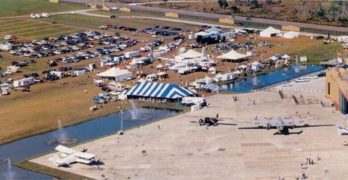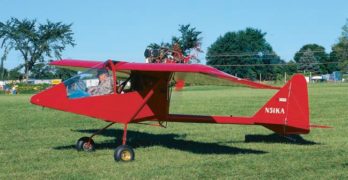Given Chuck Slusarczyk’s decades in recreational aviation, I imagine almost everyone in ultralight aviation has heard of the funny, Polish-speaking pioneer with the hard-to-pronounce last name (Slew-Sar-Chick). If Chuck had named his first business Slusarczyk Glider Supplies, pilots would have stumbled and renamed it for him. Knowing his name is a tongue twister, he wisely called it Chuck’s Glider Supplies.
In his early business years, when Chuck was younger and slimmer, he made hang gliders. Lots and lots of hang gliders. I flew one, as did thousands of others. He was one of a handful of east-of-the-Mississippi hang glider manufacturers. Being a long way from the West Coast where hang gliding was centered back in the ’70s, Chuck made the Californians nervous. They couldn’t keep an eye on his developments and he was regarded as unpredictable. Those who knew him thought the word should be innovative.
Then came powered hang gliding, such as it was in those days.
Search Results for : Vintage
Not finding exactly what you expected? Try our advanced search option.
Select a manufacturer to go straight to all our content about that manufacturer.
Select an aircraft model to go straight to all our content about that model.
IndUS – Thorpedo
All Revved and Everywhere to Go
This vintage design with a big Jabiru engine is an impressive performer.
Since its reintroduction to the aviation community by IndUS Aviation, John Thorp’s T-211 is generating more attention than at any time since he first designed the airplane.
While John worked on large aircraft, like the Navy patrol bomber P2V Neptune, he focused most of his career on small, sporty aircraft. He began designing a two-place light aircraft in the 1930s. By the 1950s his T-10 Sky Skooter powered by a 50-hp Franklin 2AC-99 engine evolved into the T-111 with a 75-hp Lycoming engine. Later it became the T-211, with a Continental O-200. It is this last version of the T-211 that IndUS now offers as a standard category aircraft. IndUS is also planning to offer the model as a light-sport aircraft (LSA) with a Jabiru 3300 engine, affectionately named the Thorpedo for its improved performance.
Product Lines – June 1995
ST. PAUL, MINN. — In April, USHGA continued what is now something of a tradition by having a strong presence at the massive Sun ‘n Fun airshow, one of the ways we can reach out to other potential new members. The Florida extravaganza has been closing on the world’s largest airshow — Oshkosh — and in 1995 nearly tied the big Wisconsin event for attendance. These conventions are the largest gatherings of pilots in the world, and I think it’s terrific hang gliding is represented. Even if you’re one of those who don’t desire growth, we need to be recognized among the greater community of pilots, if for no other reason than having some clout and contacts when one of our flying sites is threatened. ••• As if to show the effort is paying off, UNpowered ultralights were recognized in several significant ways this year. • A window was created daily to allow one hour of solely unpowered flying.
Hawk looks Good in Wood!
Not all Light-Sport Aircraft will be composite.
Beautiful imported aircraft like the CT2K, Mirage, Jabiru, or Kolb Sport seem to best represent what many pilots imagine when they hear the words “light-sport aircraft.” These shapely composite designs are speedy and modern looking. Yet we’d be foolish to ignore the entire fleet of amateur-built light-sport aircraft (LSA) candidates. One of these is Fisher Flying Products’ Dakota Hawk.
Wood Still Works!
The Dakota Hawk is a simple, wood-structure light aircraft covered in fabric. Sound familiar? Sound comfortable and well understood? You bet it does.
While the Dakota Hawk may not be seen as a “modern” design, neither is it a vintage aircraft like Fisher’s fascinating Tiger Moth replica. Instead, most pilots probably link the Dakota Hawk to a golden era of general aviation when Piper Cubs, Taylorcrafts, and Luscombes were the darlings of light flight.
Regardless of what regulatory program it operates under, this high-wing taildragger is a sweet flier that will address what many pilots want out of aviation.
All-metal, Four-stroke, Genuine Ultralight
The new light-sport aircraft (LSA) category will soon be a reality. While a best guess is that FAA’s newest rules could be announced at EAA AirVenture Oshkosh later this month, it may happen later in the year. Whenever it happens, and like many others watching closely, I hope this new concept arrives swiftly with its promise of interesting aircraft at affordable prices.
As important as LSA may be, however, the proposed new the rule doesn’t affect other enjoyable flying machines. Aircraft built under the amateur-built (51-percent) rule will continue to be a major factor. Many EAA members are building under this rule, and these aircraft will continue to offer wide choices, performance beyond that of many general aviation aircraft, and the pride of craftsmanship. LSA also leaves room for Part 103 ultralights to continue and grow. While some industry leaders see little demand for single-seat aircraft powered by small engines-and it is true that they do not make up a majority of machines-neither, however, will they disappear.
Wings and Strings 2000
Admirers of aviation and music convene at this annual Florida event.
Naturally, pilots have interests besides airplanes. I’d bet all fliers enjoy one kind or another of music. Hang glider pilots occasionally fly with a portable CD player at sites such as Torrey Pines near San Diego. The California glider port shared jointly by sailplanes, hang gliders, paragliders, and RC models offers butter-smooth ridge lift. The gentle sea breezes make for such mellow conditions that some say music complements the flying.
Yet most pilots are too busy with controls and instruments, are concentrating too hard on navigation, or are simply too engrossed in the joy of flying to want music aloft. CD players in homebuilts or factory aircraft are hardly commonplace. But another way to indulge your musical and aviation interests is to visit Florida’s Fantasy of Flight tourist attraction on the occasion of the annual Wings & Strings Americana Music Festival.
How-to-Buy a Lightplane — Part 3 of 3
In the previous two installments, we’ve discussed you, the pilot, and the many types of aircraft choices you have. As we wrap up this series, we’ll put it all together and try to help you narrow your choices to a few models.
Notice the word “try.” It is important that you understand that it is not possible to direct you to the one-and-only best choice of aircraft. Novice buyers often seek assistance but even experienced pilots can become swayed and end up purchasing the wrong aircraft for their needs and desires. Because aircraft purchases are commonly emotional decisions, it is helpful to gain a “second opinion” to help make a more rational choice.
Many years ago, at the beginning of my career writing articles in light aviation, I made a similar attempt to help hang glider pilots choose the right glider. I compared nine contemporary models to an idealized “perfect” glider and through a series of questions much like those below, tried to steer pilots to the one right glider for them.
How-to-Buy a Lightplane — Part 2 of 3
FACING THE BUYING DECISION, PART II
Last time we discussed the pilot (you!); this time we discuss the many types of aircraft choices you have. In the last installment, we’ll put these together and help you narrow your choices to a few models.
What Kind of Pilot Are You?
Let’s just say you actually know yourself. While this sounds like a comment that deserves a “Duh!” response, don’t be too quick to judge. If every pilot or buyer of aircraft knew what they needed or wanted, my job would be easier. But it isn’t so. Most pilots know something about what they want, but many don’t have enough information to make the best decision.
Some readers are “experts.” A good many ultralight or light plane enthusiasts have been around long enough and owned enough variety of ultralights to know what they like.
These veteran sport aviators represent a lot of combined experience.
How-to-Buy a Lightplane — Part 1 of 3
WANT TO BUY A LIGHTPLANE?
Task Can Be Daunting, Yet Rewarding
I’m one lucky pilot. I love airplanes and get to fly more of them than the average sky jockey. Writing pilot reports for several magazines has given me the opportunity to fly about 250 different aircraft in the last 23 years.
This makes me a “Master of None” type of pilot (except in my own planes) but does give me a feel for the huge variety of light airplanes you can buy.
The choices are fantastic. Counting the whole world of sport aircraft, you can have just about anything you want| and that’s the problem. What to buy?
TRYING TO HELP
At every airshow I attend, and through phone calls between airshow, pilots often make a request: “You’ve flown all these lightplanes, which one should I buy?”
Frankly, the question makes me uncomfortable.
While I appreciate the feeling of confidence some pilots place in my experience, telling someone what to buy is a sure way to be considered wrong eventually.
Albatros
A dashing hybrid from the European microlight scene European microlight designers are blazing new runways to the sky.
Two decades after the first powered hang gliders were turned into powered ultralights, companies now offer two styles of aircraft. As one would expect, many ultralight designers have evolved their airplanes in new ways.
These producers now offer flying machines that employ the best ideas of familiar old designs (such as sewn Dacron wings and aluminum-tubing main structures), but they combine these tried and true components with composite fuselages and welded steel parts. Many variations on this theme keeps a wide range of aircraft in the pipeline.
Taking a different approach are those designers who are emerging from the world of kit-built designs. Some developers have conventional general aviation or airline design backgrounds. Whatever their experience, these engineers create clean-sheet designs that have evolved since the early days of aviation design.
As each tries to create a new microlight, they are not bound by any traditions, other than the laws of aerodynamics.









